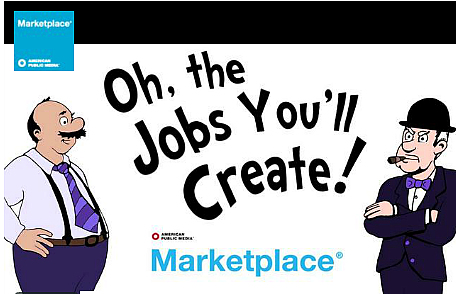Gregory Warner Gets Creative with Health Care Stories


Whether Gregory Warner was filing radio dispatches from such far-flung places as Afghanistan and Pakistan or covering healthcare for American Public Media’s Marketplace program, one of his biggest challenges remained the same.
“It’s hard to make people care,” he said.
While most Americans care far more about their own health than they do about Afghan tribal politics, crafting meaningful narratives that really get at how the system works (or doesn’t) can be just as daunting a task for a reporter.
“Most of healthcare is just unfamiliar to people,” Warner said in a keynote address Sunday at the opening session of the 2012 National Health Journalism Fellowship. “Sometimes the most urgent stories don’t feel very urgent.”
So how then does a reporter make those urgent stories on complicated healthcare topics actually feel urgent? The usual approach is to put a face on an otherwise abstract health problem, such as the diabetes epidemic. Personalizing a story, every reporter knows, is the first step to humanizing a trend and eliciting empathy. “But the problem with obesity is so multifaceted, there’s so many causes and factors, the connection between that person’s condition and the larger 10,000-foot trends we’re talking about gets lost in the noise,” Warner warns.
And just because a person has a compelling story, he adds, doesn’t necessarily mean the audience will be led to understand the deeper trend or causes. Sometimes the best solution is to seek out unusual sources or framing devices, Warner said.
For Marketplace, he made the potentially sleep-inducing story of medical billing codes interesting by finding a South Carolina urologist who has mastered the art of billing for every billable move he makes at his practice (and employing virtually his entire family, too). Or take Alix Spiegel’s innovative story for NPR’s All Things Considered, in which she offered a twist on the usual make-it-human mantra by offering the “biography of a box of pills” as a fresh way to structure her story, “How A Bone Disease Grew To Fit The Prescription.”
For a story about colonoscopies and new evidence suggesting a simpler test works just as well, Warner found that the oncologist now questioning the procedure in the Journal of the American Medical Association was the same one who had, some three decades earlier, helped launch the colonoscopy trend through another editorial.
The common link in these stories is the pursuit of sources who aren’t merely “typical” representatives of a trend. “Maybe they’re encouraging it, profiting by it — people who are not just one of those numbers, but somehow aside from those numbers,” Warner said. “I think that can be a nice approach.”
Even with an unusually compelling source, healthcare reporters still face the challenge of hacking a path through some very wonkish topics. Here Warner relays the advice of Paddy Hirsch, his former Marketplace colleague and master explainer.
“We should not explain things in the lexicon of the thing itself,” Warner said. “Don’t explain healthcare stuff by referencing other healthcare things. Instead, find something simple.”
Analogies are very useful here, as are broad cultural touchstones. Warner, recalling Hirsch, said, “He’ll use Thanksgiving to explain how proprietary trading works.”
After a reporter has found the character or angle that really makes the story sing, the possibilities for experimenting with multimedia begin. Slideshows, typically the default option, are redeemed when photos and audio seamlessly reinforce each other. Warner points to the Los Angeles Times’ “Waiting for Death” audio slideshow, in which photos at first directly echo the audio before taking on a more symbolic cast as the narrator speaks of death’s imminence.
“When we think about multimedia, there are ways in which we can keep people watching,” Warner said. One of the best ways to do that is to give the story the form of a journey, as Caitlin Kenney did in a compelling first-person video for NPR’s Planet Money in which she seeks to answer the age-old question, “Why Did My Wedding Dress Cost So Much?”
Warner’s own multimedia experiments include a video featuring hand puppets that reenact that increasingly common doctor’s office scene where Web-savvy patients view their doctors as little more than a necessary signature approving their self-diagnosis and corresponding treatment.
But creative multimedia projects like these raise the obvious question for the already overtaxed journalist: How do you find time to do this kind of stuff?
Warner advises seeking out collaborators whenever possible. “If you look around for collaboration, you find it, and you find people willing to be artistic with you,” he said. “It’s not only a nice thing to do, it’s basically essential.” Everyone has skills in which they’re “majors,” he says, so seek out other talents to fill in your “minors.”
Since multimedia projects can be time hogs, it will likely mean crafting them on the side, especially if one’s editors have other priorities. “I did most of my multimedia on the sly,” said Warner, suggesting that reporters take one month out of every six to explore new possibilities for telling complicated stories.
And don’t worry if the results aren’t exactly a Frontline-level presentation. “A story that is a journey can have lower production values and still be very productive,” Warner said.

